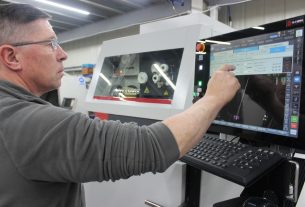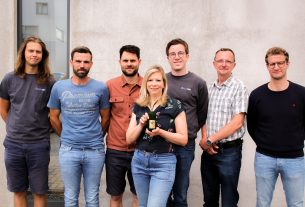ABB has turned to its own technology to understand and optimize energy consumption at its Stonehouse manufacturing and calibration centre in the UK. The result has been a 20% reduction in electricity usage plus wider sustainability benefits.
The drive towards greater operational efficiency and sustainability is a boardroom conversation in every industrial organization. Reducing energy consumption and emissions, however, is difficult to achieve without a granular picture of resource utilization and effective strategies for realizing tangible benefits. A recent exercise by ABB to enhance the efficiency of its own operations demonstrates that knowledge is indeed power when it comes to identifying areas for optimization.
ABB’s Stonehouse facility in Gloucestershire in the UK manufactures flowmeters and other devices for the analysis of gas and water treatment. The site features a dedicated calibration capability, where flowmeters measuring up to 2,800 litres per second are tested and certified before delivery to customers in the water treatment and process industries.
ABB has pledged to the EP100 global corporate energy efficiency initiative, led by Climate Group, with the goal of significantly improving energy management throughout its worldwide facilities by 2030. In 2024, Stonehouse set precise targets to monitor, analyze, optimize and control energy efficiency, including adoption of the ISO 500011 standard [1].
An initial obstacle to achieving these objectives was a lack of accurate data about the performance and energy efficiency of electrical systems at the roughly 40-year-old facility. This affected facilities managers ability to identify areas on site offering the greatest promise for achieving quantifiable reductions in energy consumption.
Building a clear picture of energy usage
Key to the solution implemented at Stonehouse is ABB Ability™ Building Analyzer, that’s been implemented as part of a broader energy management strategy. ABB’s buildings and utilities data analysis platform offers comprehensive tracking of energy consumption that encompasses various points of electricity, gas, and water usage throughout the facility. This enables comprehensive tracking of energy consumption, enabling personnel to monitor and analyze electricity and utility consumption in real time.
At Stonehouse data from multiple connected devices and systems across the site – including electricity, gas, and water flow meters – is displayed via Building Analyzer’s intuitive interface. Meters are connected to a programmable logic controller (PLC), with the Building Edge gateway also connecting to the PLC over Modbus TCP. This solution allows personnel to monitor and understand utility consumption in real time, revealing insights to enable cost savings while improving energy efficiency, sustainability, and occupant awareness.
Immediate insights
Data collected and assessed with the aid of Building Analyzer, quickly revealed valuable insights for the Stonehouse team. Five critical areas were identified as major contributors to overall energy consumption, accounting for 47 percent of the facility’s total energy usage. By focusing on these high-impact areas, the team has been able to drive substantial energy savings and contribute to sustainability efforts.
“We wanted to make significant improvements in factory energy efficiency and agreed that having accurate data was key” says John Whitbread, PAMA Division Manufacturing Manager. “Building Analyzer was straightforward to install, and the interface is easy to use. What surprised us was how quickly we could use the data to make step changes in energy usage. Being able to see the 15-minute usage data gives a clear indication of where and when energy is used, enabling us to make targeted changes that can be easily verified. Our actions in the first year will save 20 percent in electricity usage alone against a 2019 baseline.”
As a consequence of exercise, the Stonehouse team has been able to successfully identify several opportunities for improvement, including some surprising findings that have been put to good use.
Exploration of energy usage by the test facility’s large calibration pumps revealed higher consumption in the afternoon than in the mornings. This highlighted a lack of formal operating procedures for running the pumps, with two operating personnel handling the pumps differently. One operator adjusted the pump speed to vary the flow, while the other ran the pumps at full capacity and controlled the flow using the bypass valve. Initial results from standardization of pump operations indicate a reduction of 500 kilowatt-hours (kWh) per day while maintaining optimal performance, amounting to substantial savings over the course of a year.
Analysis of energy consumed by the building’s heating system indicated higher usage on Sundays than on Saturdays. This was traced to hot water timer settings on Sunday being identical to those on weekdays, leading to an adjustment of timer settings that’s achieved significant costs savings over the course of the week.
Another anomaly was uncovered in gas heating settings in the canteen area. Despite the canteen being unoccupied after lunch the heating timer remained on until 3pm, resulting in unnecessary energy consumption. Timer settings were adjusted to align with actual occupancy hours, leading to a saving of approximately 10 hours’ worth of gas heating per week.
Analysis of electricity usage also revealed that an air compressor system was needlessly running on Sunday outside production hours, leading to an adjustment of compressor timer settings.
Recognizing the opportunity to reduce energy consumption during the Christmas holiday season, a planned 10.5-day shutdown was implemented. Many devices in the facility operate on seven-day timers. Despite the holiday shutdown, these devices would still activate during this period. To address this, facilities managers manually turned off equipment including ovens, HVAC, water heaters, gas heating, air compressors, computers, demineralization plants, conveyors, and vending machines. This strategic management of equipment usage during the holiday shutdown has achieved substantial cost savings and more sustainable operations.
More opportunities for energy savings and greater sustainability
In addition to these primary energy-saving measures, managers at ABB’s Stonehouse facility have implemented several supplementary initiatives to further reduce energy consumption and costs.
All non-LED light fixtures have been replaced with energy-efficient LED fittings, improving lighting quality and significantly reducing electricity usage. What’s more, the installation of PIR (Passive Infrared) sensors in the warehouse and flat roof areas ensure that illumination is only active when needed, minimizing unnecessary energy expenditure.
The cumulative effect of all these energy-saving initiatives is enabling a remarkable 20 percent improvement in annual electricity consumption, equivalent to the energy needed to power 91 households in the United Kingdom for a year [2]. The project at Stonehouse is just one example of how organizations can manage their decarbonization journey with the help of data-driven insights that translate into tangible reductions in energy consumption and carbon emissions.
Want to know more about ABB Ability™ Building Analyzer? Get in touch today.





